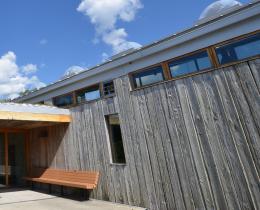Omega: In 2018 and 2019, Omega hosted conferences inspired by the Project Drawdown climate solutions frameworks. These conferences featured hundreds of participants representing dozens of organizations. Why and how did you participate in the Drawdown Learn conferences?
Jen: When we saw how close the conference was, in our home state of New York, we decided to get our students together and take them. We had students on panels with other youth and did workshops, and we were inspired by Paul Hawken’s work with Project Drawdown.
I appreciated that there were so many voices in the room. Omega did an incredible job of bringing in Indigenous perspectives, HBCUs (historically Black colleges and universities), and youth voices. It felt like a powerful mix of people coming together with a shared passion around the climate crisis. We had the chance to meet youth leaders like Alexandria Villaseñor and I appreciated how Omega integrated the youth who were there.
Omega: Did you make or deepen any helpful connections, keep in touch with, or collaborate with anyone you met afterward?
Jen: It was so important to have the opportunity to collaborate and have conversations with other presenters, including Dazzle Ekblad and Mark Lowery from New York State’s Department of Environmental Conservation and Frank Niepold of the National Oceanic and Atmospheric Administration. The BIPOC (Black, Indigenous and People of Color) Summits grew out of the relationships that were formed at Drawdown Learn. I think also some of the work we did with the US Action for Climate Empowerment (ACE) Coalition was seeded at the conference. The whole premise of it was, “We’re all in this together.”
And I must add, the space Omega provided was critical—the amazing food, the lake, yoga, and meditation. The people working on the climate crisis are deeply exhausted, and we need this kind of retreat more than ever. We need our moments of renewal, finding peace and community, and rest. Omega offered a backdrop to help us feel that we were being nourished, valued, and respected as we made connections. That’s why I think it was so powerful.
At its core, the climate crisis is about rebuilding relationships, and we need to build new relationships with everyone, people from all different perspectives, in order to build a just, sustainable world.
Omega: Did your experience at Omega inform or have any effect on the work of The Wild Center or any collaborations you participated in afterward?
Jen: I came to my executive director with the Drawdown book and said, “This is a framework we should be thinking about.” We did a deep dive into it and started thinking about what solutions exist here in the Adirondacks. Then, my executive leaders attended the Drawdown Learn Conference the following year.
We came back motivated to develop a new climate exhibit. The challenge was, we knew that content had to be interactive as well as grounded in the work that we were doing. First, we surveyed our audience using the Six Americas Super Short Survey from Yale; most of whom said they were “alarmed and concerned” about the climate. It shifted our tone and strategic direction to: How do we invite everyone? How do we make it so that people feel invited and that they already have the skills they need to be part of the climate movement? We applied for funding through the Institute of Museum and Library Services and succeeded.
What The Wild Center drew strongly from Drawdown Learn was the solutions framing, the storytelling, and hearing from all these diverse voices. And we were inspired by the conference; it gave us the foundation we needed to articulate what we wanted to see and do.
The Climate Solutions exhibit, completed in 2022, is grounded in principles of storytelling and connecting to people. This was our concept: People across sectors, generations, and backgrounds are building a web of climate solutions and are inviting all of us to become part of the movement.
Omega: Please tell us more about your new climate exhibit. How do you use it? How can people see and engage with it?
Jen: We anchored the exhibit in stories. We feature large portraits of youth leaders, scientists, BIPOC leaders that do work in traditional ecological knowledge, as well as artists, farmers, educators, and folks working in the regenerative energy space, like solar and wind. The portraits draw you in, and you can listen to audio recordings of stories through reclaimed rotary phones. We were very conscious to use renewable materials, like these older rotary phones and recycled plywood. The exhibit also highlights our youth climate program, and we have a tinkering studio that focuses on creative skill sets, such as how to make windmills.
As we get ready for our big spring/summer season coming up, we continue to use the museum as a convening space. We just held a Food Justice Summit recently, modeled after our Youth Summits; Building a Greener Adirondacks Conference will be held here for builders, designers, and architects; a public festival called ‘Plug-In’ focused on climate solutions such as going all electric; and all of our youth climate leadership programs.




